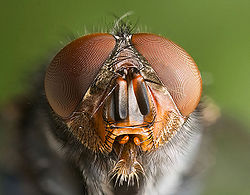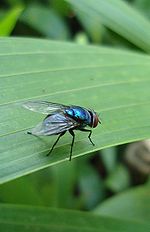.jpg)
- Kingdom: Animalia
- Phylum: Arthropoda
- Class: Insecta
- Order: Diptera
- Family: Calliphoridae
- Subfamily: Calliphorinae
- Tribus: Calliphorini
- Genus: Calliphora
- Species: C. vomitoria[2]
Calliphora Vomitoria

| Blue bottle fly |
|---|
.jpg) |
| Scientific Classification |
|
| Binomial Name |
Calliphora Vomitoria |
 |
| Up close on a Blue Bottle Flies' eyes |
The Blue Bottle Fly is a true fly from the order Diptera. These flies are characterized by their unique blue color and are known to eat dead and decaying matter. The name of the Blue Bottle Fly comes from the term “bot” which is an old term for maggot. The Blue Bottle Fly may seem unimportant but is actually really useful. First of all, they are of medical importance with their ability to transmit diseases. Secondly, they are capable of pollinating plants and serve as the main pollinators for some plants. Blue Bottle Flies are one of the 16,000 species in Order Diptera. They were created very uniquely by God.

The life cycle of the Blue Bottle Fly is common among other bottle flies. Blue Bottles reproduce sexually. Their life cycle pertains of an egg, larva, pupa and adult. The first stage is the egg. The Blue Bottle Fly egg has the appearance of a slim, light yellow or pale gray, grain of rice. The female fly will lay up to 180 eggs on suitable food materials such as a carcass or rotting flesh. In two or three days, the fly eggs will hatch. The larva has the appearance of the common house fly larva. A white or yellowish worm or caterpillar looking animal now takes the stage. The blue bottle fly larva is called a maggot. The main purpose of the maggot is to feed and grow. This stage lasts approximately 2 to 10 days. After this, the maggot will find a dry safe spot to pupate. Then a hardy cocoon is formed around the larva, changing the pupa into an adult. The pupa will take an unusually long time in its cocoon. It takes about 2 weeks to emerge. The now adult Blue Bottle Fly is 1/4-inch to 3/8-inches in size. It looks similar to the average housefly but is distinguished by its bright metallic blue color. Within 2 weeks, the new adult will be sexually mature and the process will repeat.[6]
The Blue bottle fly plays an important role in the world's ecosystem. For example, blue bottle flies are pollinators. Most will eat carrion but some will feed on pollen and nectar. They pollinate the same way as [honey bee]s, traveling from flower to flower and picking up grains of pollen on their bristly legs and transporting it to the next flower[7] Another factor is that Blue Bottle larvae is predacious. That means it will eat other flies' larvae. The Blue Bottle Fly is also eats decaying matter, such as animal corpses (even human corpses and feces, but mainly animals) and animal feces. These flies are very useful to forensic scientists in investigations. [8] Because they lay their eggs on dead and decaying matter, forensic scientists will use the development time of their larvae to tell them how long someone was dead. [9]
|
||||||||||||||||||||